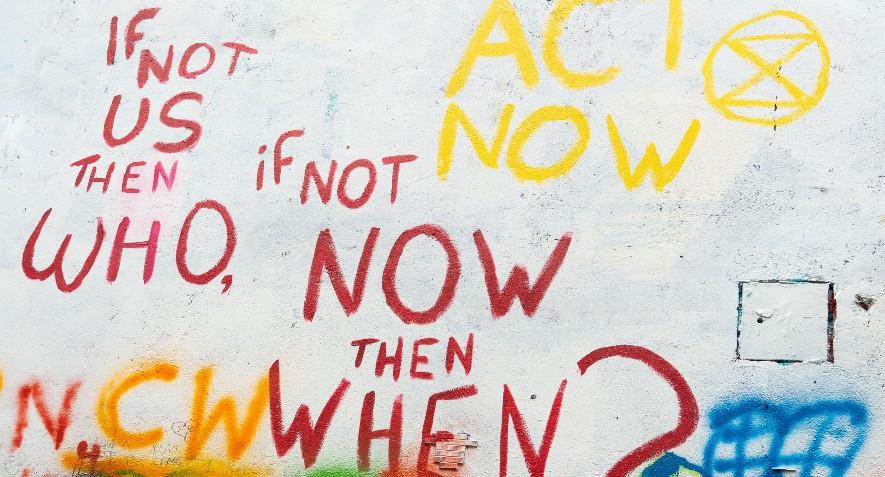
Submitted by Livia Harriman on Tue, 21/12/2021 - 00:00
What were the different activist groups at COP26 on Glasgow trying to achieve? Did they have any success?
We’ve heard many observers, scientists and activists sharing concluding thoughts on their experiences of COP26 in Glasgow last month.
Like the selfies of people travelling to Glasgow in the first couple of days - and, ironically, the many trains cancelled due to heavy storms that the British rail network is unable to cope with - we read reflections based on their specific positions within the millions of conversations that took place in different localities along the Clyde.
For now, attention is on the Glasgow climate pact, a document that falls short of almost everybody’s expectations. This fact is clearly understood, even by COP26 president Alok Sharma, appointed by a conservative government that is pushing to support a new coal mine in Cumbria. George Monbiot has bluntly called the Glasgow agreement a “suicide pact”.
Success?
Most activists agree that the summit is a historic and horrific failure, its language and commitments falling decades behind the urgent action needed now.
They see it as a death sentence for people whose countries will literally disappear from the map. This begs the question, where were these voices represented? Why, as an editorial in The Guardian asks, is the “anti-global heating movement not strong enough”?
I spent five days at events around the summit in Glasgow, and like most visitors was never able to step foot into the blue or green zones. The thing I found most striking is the disconnected realities of people that are moving around in one single place, based around one single event.
While it might be obvious that the mood and the conversations “outside” and “inside”, as it was generally framed, were very different, I want to suggest that this binary too much simplifies the multiple layers of activity and strategies pursued outside of the official negotiations. What were the different activist groups trying to achieve? Did they have any success?
It seems to me that there were at least three different layers to the activism around COP26.
These strategic choices matter, and academics and policy makers concerned for the climate would do well to pay close attention.
Civil
The official negotiations started in week one with the heads of states outlining their visions while praising their own country for being the most “ambitious” in terms of climate policy.
In this way, many tried to distract their audiences from the billions of fossil fuel subsidies that are still pumped annually into the most climate destroying industries.
Despite official claims to the contrary, Glasgow has been called by many on the ground the most exclusive COP ever.
One of the main reasons for this is the fact that many people didn’t get visas in time to attend, particularly from civil society organisations. From the onset people warned that “COP26 will be whitest and most privileged ever”.
While queuing for a coffee in the activist-filled West End of Glasgow, I had a conversation with two senior civil society leaders at COP, from the Climate Action Network and War on Want.
Congratulating
Both were furious, indicating their anger about them being excluded from key negotiations, a fate shared with many other civil society actors. “I am p***ed, it’s a s***show, they just shut us out.”
The People’s Summit, dubbed an “anti-COP” by the organisers, was the centre of a second field of activity. The COP26 Coalition had put together an expansive programme of talks and workshops over three days that took place outside the inaccessible official COP venues.
All events were open to the public. The topics were wide ranging, from panels on feminist climate justice and competing visions of a Green New Deal to climate related marginalisation in Western Sahara, to spaces dedicated to anti-oppression and BIPOC activists.
The most interesting events I attended were the so-called “Movement Assemblies” that filled the pews of Adelaide Place Baptist Church to the brink.
This was one of the few spaces where people from the “inside” reported on what had been discussed in the daily negotiations. However, these speeches seemed to mainly focus on congratulating the activists for being present and provided little information of what was going on around the negotiation tables.
Negotiator
One of the few successful examples of linking the movement and the delegates space seemed to me the question of climate repair.
Saleemul Huq, a botanist from Bangladesh, told The New York Times: “We have entered what I call the era of loss and damage”.
For years, he and other civil society groups had been pressing the UN to integrate this topic by asking the simple question: what do those most responsible for this crisis owe those most affected?
Loss and Damage was the focus of the Global Day of Action on 6 November and then was taken up as topic of official negotiations on the following Monday.
This was seen as a significant victory. As one high level civil society negotiator from South Africa told me, loss and damage “is the closest to reparations we will get”.
Diversity
However, the final deal includes nothing substantial on loss and damage. The $US100 billion pledged in the Paris Agreement, a drop in the ocean considering what is needed, as many said, remains an unfulfilled promise.
This focus on movement gathering, knowledge exchange and mutual training, however, is considered not enough by others in the climate movement.
Having cosy conversations among like-minded activists would do nothing to put pressure on the negotiators to act now, “because it’s too late”, as one Extinction Rebellion (XR) slogan puts it. The third major space of activity in Glasgow emerged by what was happening on the street.
Tens of thousands came to St George’s Square to listen to Greta Thunberg and other famous climate strikers such as Vanessa Nakate.
The 6 November 2021 march through the centre of Glasgow showcased the diversity of the climate movement.
Disobedience
In addition to established groups many assembly points in Kelvingrove Park were allocated by agenda and identity: migrant justice, faith, trade unions, Glasgow communities, youth strikers, housing, biodiversity, cycling, and, leading the march, a bloc of indigenous activists with a particularly strong contingent of people from the Amazon basin.
A fire engine of the Fire Brigade’s Union greeted the protesters after the march on Glasgow Green with the slogan, “The great are only great because we are on our knees. Let us rise”.
However, there are strong disagreements as to the strategic purpose of such marches among the movement.
“COP is fucked, what’s next?”, was the title of an event with prominent XR and Insulate Britain (IB) activists that centered on this problem.
Whether or not to go to COP26 at all was heatedly debated within XR, with some arguing that they needed to save resources for large acts of civil disobedience in spring, while others, including XR Scotland, decided to use COP for civil disobedience and mobilisation.
Dissatisfaction
As Roger Hallam, co-founder of Insulate Britain argued at the event: “When faced with evil, you either resist or you are complicit … civil disobedience is our moral duty”.
The effectiveness of direct action also was evident in Glasgow: 21 members of Scientist Rebellion that chained themselves to each other to block King George V bridge grabbed almost as much media attention as the 150.000 people strong march.
IB pushes this logic further. As we have only three to four years to avert utter calamity, a time period attributed to the UK’s former chief scientist David King, it was no longer the time to hold rallies and marches.
As Hallam puts it: “We have three or four years. And what are people doing? A March? Are you f***ing kidding me? A march? In 1984 you could do a march, that would be okay. But in 2021? This is disgusting!”
Hallam claims that especially among young people, dissatisfaction about their future being literally burnt was so rampant that it would only take a small but significant victory, and millions could be on the streets to force governments to act.
Killed
This is why IB and XR are preparing for a wave of civil disobedience never seen before in British history, to achieve what COP so miserably failed to deliver: swift, radical and justice-focused climate action.
The climate movement present at COP was divided at least in three camps: those trying to lobby negotiators in the blue zone, the justice, decolonial and intersectional rally and events-based activism such as the People’s Summit, and those who used it to prepare for mass escalation of civil disobedience post-Glasgow.
And yet, the most courageous and determined defenders of a liveable planet were mostly absent. They are the indigenous people that protect their lands from the violent intrusions of extractive industries across the globe.
At a gut-wrenching protest action outside the high fencing of Glasgow conference centre, indigenous women activists from Turtle Island / Canada held a sacred ceremony for their sisters and friends that were disappeared and killed.
Smokescreen
Many of them fell victim to the violence meted out by employees of logging companies put into what they call “man camps” in the indigenous heartlands.
The mere existence of those multiplies the incidents of violent assaults on indigenous women, making it twelve times more likely for an indigenous woman to be killed than the average Canadian.
One of the activists, Sii-am Hamilton, told the crowd: “Remember my face, look at my face. Because when I am gone, then go and look for me.”
COP26 is over. But many communities’ fight for life and death will continue, maybe more desperate and determined than ever. It is paramount for us to see through the smokescreen of casting protests as the mere background to the actual summits.
Impossible
The protest actions and the glocal relations they foster are the driving forces of change at a variety of different levels.
Will the climate movement prioritise indigenous land struggles, a “moderate flank”, “co- liberation”, escalation of civil disobedience or move towards acts of sabotage?
These strategic choices matter, and academics and policymakers concerned for the climate would do well to pay close attention to what decisions will be made in the aftermath of COP26.
We don’t know what they will be, but one thing is for sure: You won’t read about them in the newspapers until suddenly a new form of movement emerges that is impossible to ignore.
Dr Tobias Müller
Tobias is an affiliated lecturer at the Department of Politics and International Studies at Cambridge and a postdoctoral researcher at Leiden University.
He is the principal investigator of a research project on intersectional climate justice funded by The New Institute and has recently been published in Nature.
Keep up with Tobias on Twitter>>
This article was originally published in The Ecologist online on 22 November 2021. See the original article here>>
Image Credit: Rod Long via Unsplash

